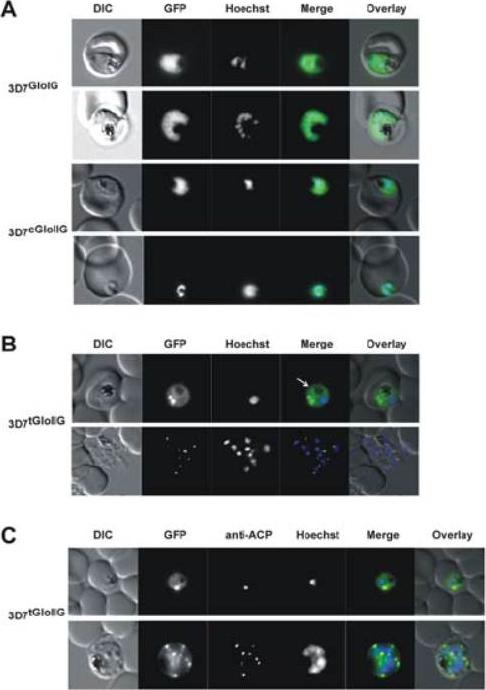PF3D7_0406400 cytosolic glyoxalase II (cGloII)
Disruptability [+]
| Species | Disruptability | Reference | Submitter | |
|---|---|---|---|---|
| P. falciparum 3D7 |
Possible |
29354648 Clonal 3D7Δcglo2 knockout parasites maintained about one third of the Glo2 activity and had no altered susceptibility towards exogenous 2-oxoaldehydes. None of the clonal knockout strains had a suspicious morphology during asexual blood-stage development when compared to the wild-type 3D7 strain. Even though blood-stage growth rates appeared to be slightly reduced for single knockout clones, differences to the wild-type strain were not significant according to statistical analyses. However, 3D7Δcglo2 parasites had an increased gametocytemia compared to the parental line, indicating that the lack of PfcGlo2 results in increased gametocyte induction. |
Marcel Deponte, Department of Chemistry/Biochemistry, University of Kaiserslautern | |
| P. berghei ANKA |
Possible |
RMgm-4976 | Imported from RMgmDB | |
Mutant phenotypes [+]
| Species | Stage | Phenotype | Reference | Submitter |
|---|---|---|---|---|
| P. falciparum 3D7 | Asexual |
No difference |
29354648 Clonal 3D7Δcglo2 knockout parasites maintained about one third of the Glo2 activity and had no altered susceptibility towards exogenous 2-oxoaldehydes. None of the clonal knockout strains had a suspicious morphology during asexual blood-stage development when compared to the wild-type 3D7 strain. Even though blood-stage growth rates appeared to be slightly reduced for single knockout clones, differences to the wild-type strain were not significant according to statistical analyses. However, 3D7Δcglo2 parasites had an increased gametocytemia compared to the parental line, indicating that the lack of PfcGlo2 results in increased gametocyte induction. |
Marcel Deponte, Department of Chemistry/Biochemistry, University of Kaiserslautern |
| P. falciparum 3D7 | Gametocyte |
Difference from wild-type |
29354648 Clonal 3D7Δcglo2 knockout parasites maintained about one third of the Glo2 activity and had no altered susceptibility towards exogenous 2-oxoaldehydes. None of the clonal knockout strains had a suspicious morphology during asexual blood-stage development when compared to the wild-type 3D7 strain. Even though blood-stage growth rates appeared to be slightly reduced for single knockout clones, differences to the wild-type strain were not significant according to statistical analyses. However, 3D7Δcglo2 parasites had an increased gametocytemia compared to the parental line, indicating that the lack of PfcGlo2 results in increased gametocyte induction. |
Marcel Deponte, Department of Chemistry/Biochemistry, University of Kaiserslautern |
| P. berghei ANKA | Asexual |
No difference |
RMgm-4976 | Imported from RMgmDB |
| P. berghei ANKA | Liver |
No difference |
RMgm-4976 | Imported from RMgmDB |
Imaging data (from Malaria Metabolic Pathways)

Localization of GloI, cGloII and tGloII GFP-fusion constructs in infectederythrocytes. (A) Live cell imaging of erythrocytes infected with transgenic parasite lines 3D7GloIG (upper panels) and 3D7cGloIIG (lower panels). GFP fluorescence was evident only within the body of the parasite (excluding the food vacuole). (B) Live cell imaging of erythrocytes infected with 3D7tGloIIG (apicoplast). A distinct fluorescent “dot” was seen in both trophozoite (upper panel) and merozoite (lower panel) stage parasites, indicative of an apicoplast localization. The white arrow shows additional low levels in the arasitophorous vacuole. (C) Colocalization of tGloIIGFP and the apicoplast marker ACP in fixed, immunodecorated cells. Note the high degree of overlap between tGloII-GFP and ACP.Urscher M, Przyborski JM, Imoto M, Deponte M. Distinct subcellular localization in the cytosol and apicoplast, unexpected dimerization and inhibition of Plasmodium falciparum glyoxalases. Mol Microbiol. 2010 76:92-103. Copyright John Wiley & Sons Ltd. 2010.
See original on MMPMore information
| PlasmoDB | PF3D7_0406400 |
| GeneDB | PF3D7_0406400 |
| Malaria Metabolic Pathways | Localisation images Pathways mapped to |
| Previous ID(s) | MAL4P1.62b, PFD0311w |
| Orthologs | PBANKA_1004000 , PCHAS_1004900 , PKNH_0304400 , PVP01_0305700 , PVX_000925 , PY17X_1005400 |
| Google Scholar | Search for all mentions of this gene |